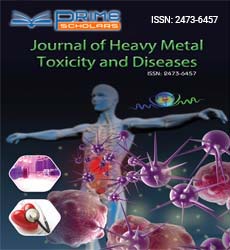Perspective - (2024) Volume 9, Issue 5
Education and Awareness Campaigns: Empowering Communities to Combat Heavy Metal Exposure
Claire Shaw*
Department of Awareness, University of Navarra, Spain
*Correspondence:
Claire Shaw,
Department of Awareness, University of Navarra,
Spain,
Email:
Received: 01-Oct-2024, Manuscript No. ipjhmct-24-21856;
Editor assigned: 03-Oct-2024, Pre QC No. ipjhmct-24-21856 (PQ);
Reviewed: 17-Oct-2024, QC No. ipjhmct-24-21856;
Revised: 22-Oct-2024, Manuscript No. ipjhmct-24-21856 (R);
Published:
29-Oct-2024, DOI: 10.21767/2473-6457.24.5.43
Introduction
Heavy metal exposure remains a significant public health
concern, affecting millions worldwide. Metals such as lead,
mercury, arsenic, and cadmium can have detrimental effects
on health, particularly for vulnerable populations like children
and pregnant women. Effective education and awareness
campaigns are crucial in informing communities about the
sources of heavy metal exposure, the associated risks, and
strategies for prevention. This article explores the importance of
these campaigns, successful strategies, and the role they play in
fostering community resilience.
Description
Industrial discharge, agricultural runoff, and deteriorating
infrastructure can introduce heavy metals into drinking water
supplies. Pesticides, industrial waste, and lead-based paints can
lead to soil contamination, affecting food crops and residential
areas. Emissions from vehicles and industries can release heavy
metals into the atmosphere, where they can settle on land and
water bodies. Certain cosmetics, toys, and electronic devices
may contain heavy metals, posing risks during use and disposal.
Understanding these sources is essential for communities to
identify potential risks and take proactive measures. Awareness
campaigns empower individuals and families to make informed
choices about their environment, health, and lifestyle.
Knowledge of exposure sources allows communities to take
preventative actions, such as testing their water or avoiding
certain products. Education can lead to behavioural changes that
reduce exposure. Children, pregnant women, and low-income
families often face heightened risks from heavy metal exposure.
Targeted education initiatives can provide these groups with
critical information tailored to their specific needs, ensuring their
safety. Hosting workshops and seminars in community centers,
schools, and healthcare facilities can facilitate direct engagement
with residents. These events can cover topics such as the risks
of heavy metal exposure, safe practices, and available resources.
Developing brochures, flyers, and infographics can help
disseminate information effectively. These materials should be
clear, visually appealing, and translated into multiple languages to
reach diverse populations. Utilizing social media platforms allows
campaigns to reach a broader audience. Creative content, such
as videos, quizzes, and interactive posts, can engage community
members and raise awareness about heavy metal exposure in a
relatable manner. Collaborating with local health departments,
schools, non-profit organizations, and environmental groups
can amplify the reach and impact of awareness campaigns.
These partnerships can provide additional resources, expertise,
and credibility. Providing resources for testing water, soil, and
household items for heavy metals can empower communities
to take direct action. Campaigns can partner with laboratories
or local health departments to facilitate these testing services.
Assessing knowledge levels, attitudes, and behaviors before and
after campaigns can provide insights into their impact. Tracking
attendance at workshops, participation in testing programs, and
interactions on social media can indicate community interest and
involvement. Monitoring changes in health indicators, such as
rates of lead poisoning or other heavy metal-related illnesses,
can demonstrate the long-term benefits of education initiatives.
Conclusion
Education and awareness campaigns play a crucial role in informing
communities about heavy metal exposure and prevention
strategies. By empowering individuals with knowledge, fostering
behavioral changes, and advocating for policy improvements,
these initiatives can significantly reduce the risks associated
with heavy metal toxicity. As we continue to face environmental
challenges, prioritizing education and awareness will be essential
for building resilient communities capable of protecting their
health and well-being. Through collaboration, creativity, and
commitment, we can create a safer and healthier future for all.
Citation: Shaw C (2024) Education and Awareness Campaigns: Empowering Communities to Combat Heavy Metal Exposure. J Heavy Met Toxicity Dis. 09:43.
Copyright: © 2024 Shaw C. This is an open-access article distributed under the terms of the Creative Commons Attribution License, which permits unrestricted use, distribution, and reproduction in any medium, provided the original author and source are credited.

